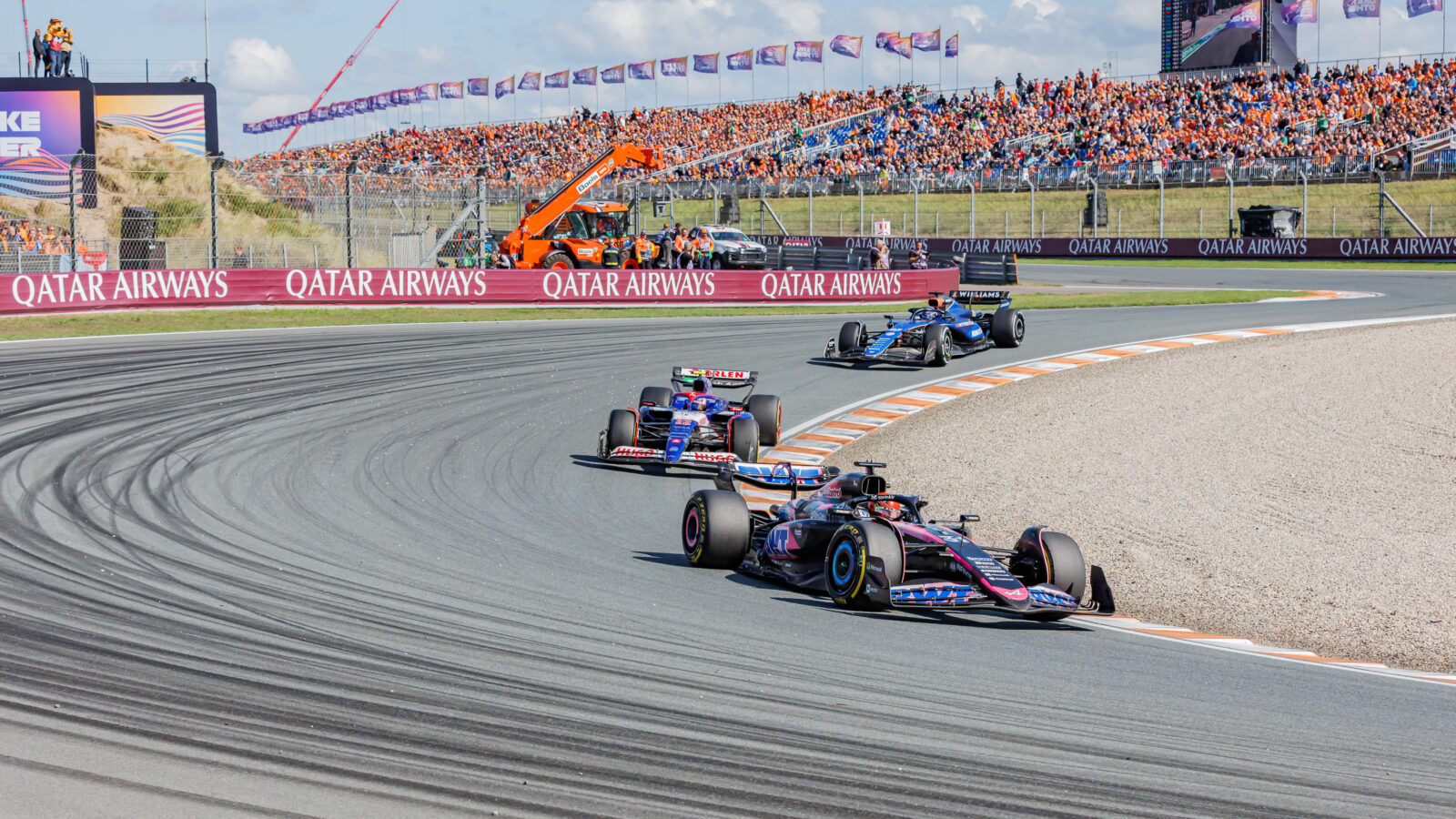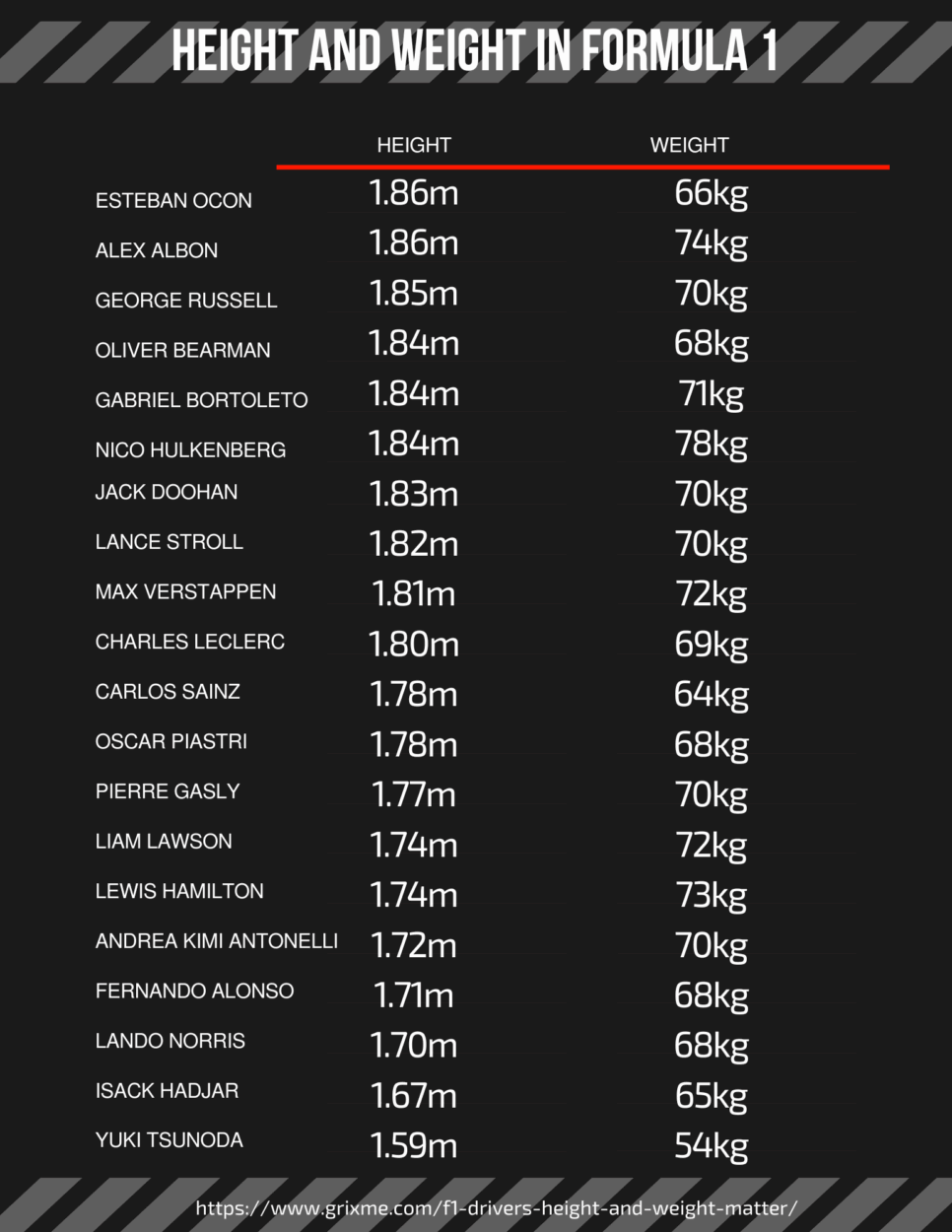Let’s talk Formula 1, shall we? Not the roaring engines or the adrenaline rush (though those are pretty cool), but something a little more… personal. Something that might make you look at these racing gods in a whole new light. I’m talking about height and weight of F1 drivers.
Yes, folks, we’re diving into the surprisingly complex world of F1 drivers’ physical dimensions. Does Yuki Tsunoda’s compact frame give him an edge over George Russell’s lanky leverage? Does carrying a few extra kilos mean the difference between a podium finish and a polite wave from the back of the pack? Hold on because these make the matter but in a different way than we are used to thinking about it.
Spoiler: It’s Not Just About Looking Good in a Fireproof Suit.
The Numbers Game: Height and Weight in the F1 World
Here’s the starting grid, statistically speaking:
- Average F1 Driver Height (2025): 1.74 meters – shorter than Brad Pitt but probably faster around a corner.
- Average F1 Driver Weight (2025): 67 kg – lighter than a vending machine snack run. But can your candy bar handle 5G forces?
But averages don’t tell the whole story. Let’s meet the extremes:
- The Short King: Yuki Tsunoda, at a mighty 1.59m (5’3”) and 54kg (119 lbs). The dude’s basically a human go-kart.
- The Gentle Giant: Nico Hulkenberg towering over the grid at 1.84m (6’0”) and packing a respectable 78kg (172 lbs). Hulk smash… the competition!
Now, does this difference translate into on-track performance? Does Tsunoda’s low center of gravity make him a demon in the corners, while Hulkenberg’s sheer size gives him an advantage in a straight line?
The answer, as always, is a bit more nuanced than a simple yes or no.

How Much Do F1 Drivers Weigh? More Than You Think (Or Less?)
You might be surprised to learn that there are actually two significant weight limits in the 2025 Formula 1 season:
- The Car: At least 800kg (1,764 lbs) with empty tanks without a driver.
- The Driver: At least 82kg (180.8 lbs), including the driver, their equipment (suit, helmet, shoes, gloves), and any ballast.
That’s the key. Wait, what? Even though Tsunoda might tip the scales at a featherweight 54kg, he needs to add 28kg of ballast to the car to meet that minimum weight! It feels counterintuitive, like forcing a supermodel to wear a weighted vest.
Why the Minimum Weight?
Why all this fuss about weight?
Simple: Performance.
Every extra kilo slows the car down. Mercedes driver George Russell found out the hard way when his car was found to be underweight for just 1,5 kgs after the Belgian Grand Prix, costing him the victory. Every gram counts.
The FIA understands the challenges of maintaining peak physical fitness, so the minimum weight for drivers has been increased by 2kg to 82kg from 2025.
This seemingly small change is a big deal. It gives drivers more leeway to maintain muscle mass and avoid extreme dieting, especially in demanding race conditions. It also closes a loophole that allowed teams to exploit the weight limit by prioritizing lighter equipment.
But what about common beliefs about small drivers to get the advantage? Yes, the possibility exists. Because the team can place the ballast’s weight to optimize the car’s handling better. On the other hand, besides Nico Hulkenberg, no one weighs more than 75kg, so most of them have to use the additional ballast.
Was the weight the only obstacle to preventing Hulk from the podiums? I’m not sure.
The Big Question: Does Height Really Matter in F1?
This is where things get interesting. While weight is clearly regulated, tallness is a bit more… squishy.
The Tall Tales:
- Cramped Cockpits: Taller drivers might feel cramped in the cockpit, which can affect comfort and, potentially, performance. Remember George Russell, who felt more pain than Lewis Hamilton when Mercedes was porpoising in 2022? That’s not fun!
- Aerodynamic Drag: Some say taller drivers create more aerodynamic drag, reducing top speed. However, the impact is minimal, especially with modern F1 car design.
The Short Stories:
- Pedal Problems. Yes, shorter racers may struggle to reach the pedals. In 2021, AlphaTauri had to modify Yuki Tsunoda’s car to allow him to meet the controls. Awkward!
- Center of Gravity: Smaller, lighter drivers theoretically have a lower center of gravity, which could improve handling. But again, the difference is probably negligible.
The Reality:
Ultimately, tallness is less of a factor than you might think. It’s all about finding the right balance between the values and overall physical fitness.
So, does it matter? Yes, but only in terms of the balance.

Weight, Height, and the Pursuit of Physical Perfection
Formula 1 drivers are not your average Joes (or Joselines). They’re athletes at the peak of physical conditioning. So, the balance means they need to be:
- Strong: To handle the immense G-forces experienced during braking and cornering.
- Enduring: To withstand the heat, fatigue, and mental strain of a two-hour race.
- Light: To minimize the car’s overall weight and maximize performance.
This means grueling training regimens, strict diets, and constant weight monitoring. Often, drivers need to lose weight before races in hot climates such as Qatar, Saudi Arabia, and Singapore to avoid dehydration. Therefore, you won’t find any driver with over 80kg fit.
The Ideal Formula: Is There a Magic Number?
Is there a secret formula for the perfect F1 driver height and weight? Some people swear by Paul Broca’s formula (Ideal weight = Stature in cm – 100), which seems to work pretty well for drivers like:
- Lewis Hamilton (1.74m, 73kg)
- Oscar Piastri (1.78m, 68kg)
- Max Verstappen (1.81m, 72kg)
- Isack Hadjar (1.67m, 65kg)
- Andrea Kimi Antonelli (1.72m, 70kg)
- Liam Lawson (1.74m, 72kg)
Ultimately, ideal values are unique parameters for each individual. It’s about finding a balance that allows them to perform at their best.
Fun F1 Facts to Impress Your Friends
Okay, let’s drop some knowledge bombs at your next F1 viewing party:
- The tallest F1 Driver Ever is probably Justin Wilson – 1.93 meters (6’4”).
- The Hulkenberg Weight Puzzle: While Nico Hulkenberg might be the heaviest on the current grid, he’s far from the heaviest F1 driver in history, Rubens Barrichello, whose racing weight was around 80 kg (176 lbs).
- The shortest F1 Track is Circuit de Monaco, obviously. (Okay, that one’s obvious.)
The Verdict: It’s All About Balance, Baby!
So, does the height and weight of F1 drivers really matter? Yes, but not in the way you might think.
It’s not about being the tallest or the lightest. It’s about finding the right balance between physical size, strength, endurance, and overall fitness. It’s about being comfortable in the car and able to handle the immense physical and mental demands of Formula 1 racing. All the rest – is what F1 engineers can fix, repair, optimize, set, and so on.
In the end, it’s about the driver’s personal feelings. Are they comfortable with their size? Can they perform at their best? That’s what truly matters. Now, go forth and impress your friends with your newfound F1 knowledge! Just don’t start measuring them with a tape measure. That might be weird.



